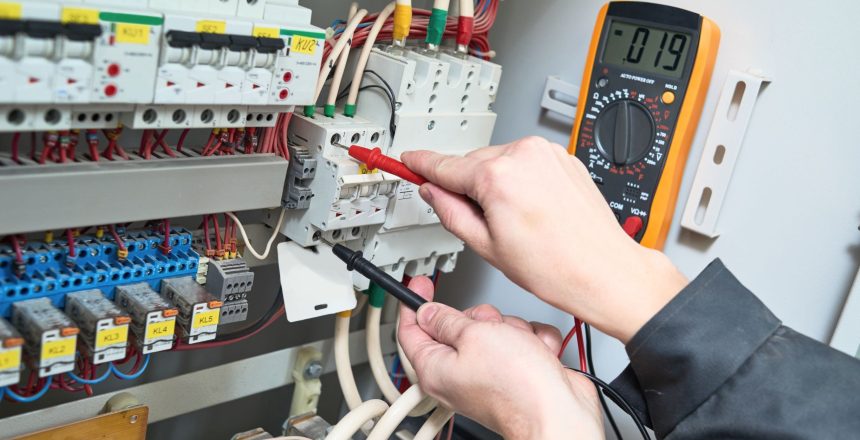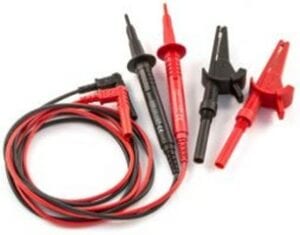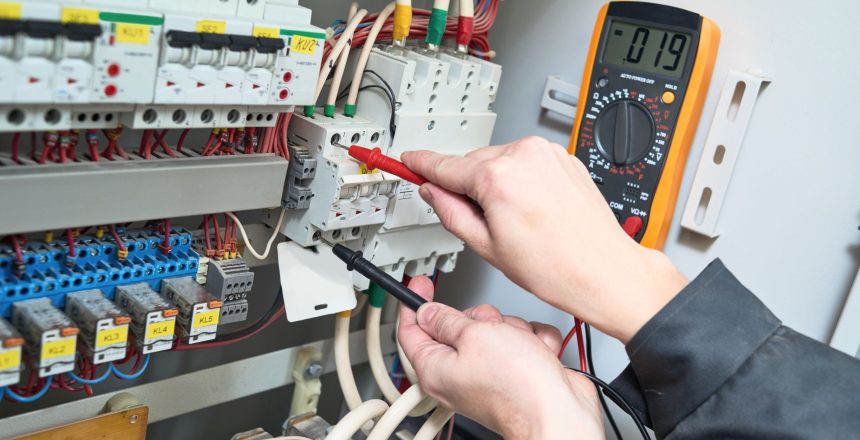Test instruments and test leads are a temporary connection to electrical systems, often live at the time, for the purpose of making measurements to establish or confirm various parameters. Andrew Linley, Compliance Director at Electrical Safety UK Ltd looks at some of the standards that exist that we must comply with and that we should take into consideration whilst undertaking measurement tasks using test instruments.
Test instruments and measuring devices are used regularly in the electrical installation and maintenance sectors, often without incident, and in many cases without a second thought by the user. We assume that the instruments are capable of undertaking the measurement without risk to the user, and we rarely consider the potential outcomes if things were to go wrong. SI 1989/635, more commonly known as the Electricity at Work Regulations 1989 refers to the need to avoid danger from arising, or protect against its existence.
Regulation 2 defined danger, in the context of electrical systems, as the ‘risk of injury’ and that ‘injury means death or personal injury from electric shock, electric burn, electrical explosion or arcing, or from fire or explosion initiated by electrical energy, where any such death or injury is associated with the generation, provision, transmission, transformation, rectification, conversion, conduction, distribution, control, storage, measurement or use of electrical energy’.
The context of measurement and test instruments can be very wide, this document considers the following instruments used on Low Voltage and Extra-Low Voltage systems for the purpose of testing or measurement:
- Approved Voltage Indicators and test Lamps (AVIs)
- Digital Multimeters (DMMs)
- Multifunction Test Instruments (MFTs)
- Separate Test Instruments such as insulation Resistance / Continuity, Loop Impedance/PSC and RCD
- Phase sequence testers
- Earth electrode resistance testers.
Before looking at the Omnibus Regulation of the Electricity at Work Regulations 1989, it is worth pointing out that, where relevant, all aspects of the Regulations must be complied with, such as:
- Regulation 5- strength and capability of electrical equipment
- Regulation 6- adverse or hazardous environments
- Regulation 7- insulation, protection, and placing of conductors
- Regulation 10- connections
- Regulation 11- means of protecting from excess of current
- Regulation 14- working on or near live conductors
- Regulation 15- working space, access, and lighting
- Regulation 16- persons to be competent to prevent danger and injury
Regulation 4; systems, work activities, and protective equipment; is where the story commences, with testing typically being carried out to achieve compliance with regulation 4(1) (construction) or regulation 4(2) (maintenance). Regulation 4(3) relates to work activities and requires that safe systems of work be in place such that danger will not arise. This includes testing practices. Many documents have been written to assist in achieving compliance with this, most notably IET Guidance Note 3- Inspection and Testing. HSR25 the Electricity at Work Regulations 1989, Guidance on Regulations makes reference to the preference for all work to undertaken with conductors made dead, with testing included in this requirement- there have to be good reasons (as set out in regulation 14) for live testing to be taking place. Regulation 4(4) relates to equipment provided to be suitable, well maintained, and used properly. It should be noted that since regulation 4(4) is not qualified by ‘so far as is reasonably practicable’, it is absolute in its requirement and compliance is mandatory.
HSG85 Electricity at Work, Safe Working Practices is an HSE publication that considers Actions connected to working dead and working live, including processes for determining which process is most appropriate to allow work to be completed safely, and good practices to be followed to achieve this. All of this is based on Risk Assessment and all works should be planned well in advance.
Testing on energised (or electrically charged) systems or testing on conductors made dead, but in the proximity of parts that are live or electrically charged classes as live working- this includes using an Approved Voltage Indicator (AVI) or test lamp to confirm that a conductor is dead (since until the process is complete the assumption is that the conductor is live and dangerous). Consider that some test instruments (such as an Insulation Resistance Tester) will apply a hazardous voltage to circuits that are dead and again falls into the remit of live working. Where danger might exist, suitable precautions shall be taken.
BS 7671:2018+A1:2020 sets out the requirements for electrical installations, Part 6 details the criteria for inspection and testing, focussing on Initial Verification and Periodic Inspection and Testing. We will be familiar with the documents that are completed and issued being Electrical Installation Certificates, Minor Works Certificates, and Electrical Installation Condition Reports. Part 6 is the UK implementation of IEC 60364-6 Low voltage electrical installations- Part 6- Verification.
Part 6 sets out the criteria for testing and in the case of Initial Verification the sequence in which it should be carried out but does not state how the tests should be completed. IET Guidance Note 3- Inspection and Testing (GN3) is where this information can be found with more condensed guidance found in the IET On-Site Guide.
Section 4 of Guidance Note 3 refers to test instruments and equipment and makes reference to BS EN 61010- Safety requirements for electrical equipment for measurement, control, and laboratory use, and is the basic safety standard for electrical test instruments. Reference is also made to BS EN 61557 Electrical safety in low voltage distribution systems up to 1000 V a.c. and 1500 V d.c. Equipment for testing, measuring or monitoring of protective measures. This standard includes performance requirements and requires compliance with BS EN 61010. Guidance Note 3 recognises that leads compliant with HSE document GS 38 should be adequate. Specifically, there is a requirement to protect the user of test instruments when they may be at risk of making contact with circuits that are energised at a hazardous level.
BS EN 50110- Operation of electrical installations, an often overlooked standard, sets out the requirements for functional checks including measurement and testing. A requirement to use suitable and safe instruments by skilled or instructed persons exists and precautions against electric shocks, the effects of short-circuits and arcing must be guarded against. Again, the focus is on working on systems made dead.
GS38 Electrical test equipment for use on low voltage electrical systems is a Health and Safety Executive (HSE) general series guidance note, originally called electrical test equipment for use by electricians. Throughout the document, reference has been made to the reduced risks of systems and therefore testing, carried out on extra-low voltage systems as significantly minimising the dangers associated with electricity, and should be the default approach. Test leads should be appropriately constructed to avoid danger taking account of all of the hazards present, for example, testing on a 24-volt battery may not present an electric shock risk, but short-circuiting battery terminals with excessively long bare test probes carries a short-circuit risk with the potential for heavy current to flow.
Consider a test for continuity carried out with a low resistance ohmmeter, a multifunction test instrument of the continuity setting of a digital multimeter. The circuit should have already been isolated, secured and the absence of voltage confirmed. This being the case, the test instrument will use its internal power source to perform the test, typically at a voltage of between 4 and 24 volts a.c. or d.c. Short-circuiting the test probes will result in indicating a very low resistance measurement, opening the test probes should indicate a very high resistance reading.


On systems that are dead the risk posed is minimal (assuming the check is not being undertaken in a hazardous area such as a potentially explosive atmosphere) and the construction of the test leads need to offer only basic safety features. However, where testing is being carried out within an enclosure containing live parts, or parts that could otherwise be (or could become) charged, more robust test leads must be used and safe systems of work should take into account the additional risks that may be present.
How Accidents Happen
It is recognised that unsuitable test equipment can cause serious burns or electric shock, including from arcing or ‘flashover’. Consideration must also be given to chemical burns (such as from battery acid) or falls from heights as the result of a ‘mishap’.
Common causes of accidents include:
- Inadequately insulated test probes (including exposed tips)
- Excessive current drawn through probes, leads, and instruments
- Inadequate or damaged test leads
- Removal of manufacturers insulation or covers
- Exposed terminals on instruments, or test leads becoming detached and exposing live parts
- Incorrect use, or setting of instruments
- Incorrect category of equipment for use on the system
- Inadequate maintenance
- Failing to inspect the instrument before use.
Category of Test Instruments
Not all test instruments are equal, and where on the electrical system we use them is important to note. Some instruments are capable of dealing with the high energy that is present at the origin of an electrical installation, whereas others are typically suited to use on an electrical system where there are varying levels of protection in place between the meter and the supply transformer or other source of supply.
Typically, instruments used at the origin of an electrical installation such as on distribution, and at the point of entry to a building should be CAT IV and rated for the maximum nominal voltage likely to be present at that point. For instruments used within the electrical systems of the building, CAT III may be used, although obviously, instruments rated at CAT IV would also be appropriate. Great care must be taken when using instruments rated at CAT II or lower.







